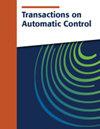离散事件系统框架下的复杂事件识别
IF 7
1区 计算机科学
Q1 AUTOMATION & CONTROL SYSTEMS
引用次数: 0
摘要
识别由原始数据揭示的复杂事件是一项日益重要的任务,它是系统监控和决策的基础之一。我们的目标是准确识别已发生的复杂事件,即从原始数据中唯一地确定已发生的复杂事件序列。我们将数据源的输出抽象为一组原子事件,然后使用一个自动机来描述给定系统可以生成的所有原子事件序列。我们将复杂事件表示为一组原子事件序列。对于给定的原子事件序列和待识别的复杂事件,我们引入了“划分”的概念来表示可能的单个复杂事件序列。通过构造一个包含所有可能分区的增广自动机,我们得到了复杂事件识别问题可解的充分必要条件。然后我们找到一个算法来检查条件。当复杂事件识别问题可以解决时,任何发生的复杂事件都可以通过现有的方法,如Aho-Corasick算法,准确、及时地在线确定。本文章由计算机程序翻译,如有差异,请以英文原文为准。
Complex Event Recognition Within a Discrete Event System Framework
Recognizing complex events revealed by raw data is an increasingly crucial task that serves as one of the foundations for system monitoring and decision making. Our goal is to accurately recognize the occurred complex events, that is, uniquely determine the occurred complex event sequence from the raw data. We abstract the outputs of data sources as a set of atomic events, and then, use an automaton to describe all atomic event sequences that can be generated by the given system. We represent a complex event as a set of atomic event sequences. For a given atomic event sequence and a complex event to be recognized, we introduce the notion of “partition” to stand for a possible single complex event sequence. By constructing an augmented automaton that includes all possible partitions, we derive a necessary and sufficient condition for the complex event recognition problem to be solvable. We then find an algorithm to check the condition. When the complex event recognition problem is solvable, any occurred complex event can be determined accurately and promptly online with existing methods like the Aho–Corasick algorithm.
求助全文
通过发布文献求助,成功后即可免费获取论文全文。
去求助
来源期刊

IEEE Transactions on Automatic Control
工程技术-工程:电子与电气
CiteScore
11.30
自引率
5.90%
发文量
824
审稿时长
9 months
期刊介绍:
In the IEEE Transactions on Automatic Control, the IEEE Control Systems Society publishes high-quality papers on the theory, design, and applications of control engineering. Two types of contributions are regularly considered:
1) Papers: Presentation of significant research, development, or application of control concepts.
2) Technical Notes and Correspondence: Brief technical notes, comments on published areas or established control topics, corrections to papers and notes published in the Transactions.
In addition, special papers (tutorials, surveys, and perspectives on the theory and applications of control systems topics) are solicited.
 求助内容:
求助内容: 应助结果提醒方式:
应助结果提醒方式:


